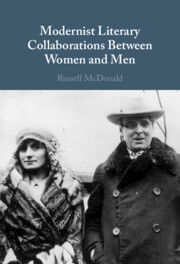Book contents
- Modernist Literary Collaborations Between Women and Men
- Modernist Literary Collaborations Between Women and Men
- Copyright page
- Dedication
- Contents
- Figures
- Acknowledgments
- Abbreviations
- Introduction
- Chapter 1 Imagining Two as One: Collaboration and the Discourse of Sex Relations in Early Modernism
- Chapter 2 The Discord Aesthetic in D. H. Lawrence’s Collaborations with Women
- Chapter 3 “The Fight to Be Affectionate”: Textual Intimacy and the Drive to Animate Marriage
- Chapter 4 “The Yolk and White of the One Shell”: Modernism’s Androgynous Textual Bodies
- Chapter 5 Conclusion: Being a Genius Together
- Notes
- Works Cited
- Index
Chapter 1 - Imagining Two as One: Collaboration and the Discourse of Sex Relations in Early Modernism
Published online by Cambridge University Press: 20 October 2022
- Modernist Literary Collaborations Between Women and Men
- Modernist Literary Collaborations Between Women and Men
- Copyright page
- Dedication
- Contents
- Figures
- Acknowledgments
- Abbreviations
- Introduction
- Chapter 1 Imagining Two as One: Collaboration and the Discourse of Sex Relations in Early Modernism
- Chapter 2 The Discord Aesthetic in D. H. Lawrence’s Collaborations with Women
- Chapter 3 “The Fight to Be Affectionate”: Textual Intimacy and the Drive to Animate Marriage
- Chapter 4 “The Yolk and White of the One Shell”: Modernism’s Androgynous Textual Bodies
- Chapter 5 Conclusion: Being a Genius Together
- Notes
- Works Cited
- Index
Summary
Chapter 1 provides historical context for the advent of cross-sex collaboration as a widespread modernist practice by examining the efforts of several writers and intellectuals between 1885 and 1908 to theorize the gendered nature of creativity or imagine mutually satisfying, socially transformative ways in which men and women might work together outside of traditional marriage. Three recurring subjects of concern emerge that shape the discourse regarding relations between the sexes at the time: marriage, androgyny, and genius. All three of these ideas, I argue, promise to fulfill the age-old fantasy of allowing individuals to recapture a lost state of primordial wholeness by uniting two opposite natures as one. The historical analysis in this chapter also provides a frame for examining two co-signed, late-nineteenth-century works that exemplify how some writers began to view cross-sex collaboration as ideally suited for exploring one or more of the subjects of marriage, androgyny, and genius: Eleanor Marx and Edward Aveling’s 1886 pamphlet The Woman Question, and Thomas Hardy and Florence Henniker’s 1894 short story “The Spectre of the Real.”
- Type
- Chapter
- Information
- Modernist Literary Collaborations between Women and Men , pp. 25 - 65Publisher: Cambridge University PressPrint publication year: 2022



